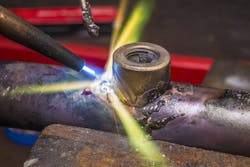Weld Them or Braze Them? How Should You Join Metal Parts?
This article was updated March 7, 2023. It was originally published Dec. 9, 2004.
Engineers have an impressive array of ways to join two pieces of metal including adhesives, nuts and bolts, and a long list of other mechanical fasteners. But if engineers need a strong, permanent joint, there seem to be only two choices: welding or brazing.
Welding puts metal pieces together by melting and fusing them. Additive fillers are also added to the joint. To fuse the two pieces together, heat is applied at the joint, and its temperature must be greater than the metal and filler’s melting points. The resulting joints are usually as strong or stronger than the base materials.
Brazing uses temperatures much lower than those needed for welding; in fact, in brazing, the base metals do not melt. Rather, the heat melts a filler metal and draws it into the joint by capillary action. This creates a metallurgical bond between the filler metal and the surface of the parts.
As with welded joints, brazed ones are often stronger than the individual parts. For example, a brazed steel joint can have a tensile strength over 130,000 psi. And the lower temperatures of brazing, generally 1,150 to 1,600°F, means most of the steel’s physical properties do not change. There can be some minimal distortion and warping which lowers the stresses in the joint and its surroundings. Lower temperatures also mean less energy, so brazing is less costly than welding.
Both welding and brazing create durable, permanent joints. But which is best for a given application? Here are several key considerations that could help design teams choose between the two:
Assembly size. Welding is better for joining large assemblies. Brazing heats a broad area, often the entire assembly. Larger assemblies dissipate heat, making it difficult to reach the filler material’s flow-point temperature. Welding uses intense localized heat, which sidesteps this brazing drawback.
Thickness. If both pieces of metal being joined are more than 0.5 in. thick, either method will work well. For thinner parts, however, brazing is go-to method. For example, creating a T-joint between 0.005-in. sheet metal and 0.5-in. thick steel would be best done using brazing. If welding were tried, its intense heat would likely burn through or warp the thin section. Brazing’s broader heating and lower temperature joins the sections without distorting either.
Linear and spot welds. Both joining methods can create spot joints. But welding relies on localized heat, which conveys some advantages. For example, when joining two metal strips at a single point, electrical-resistance welding is a fast, economical way to accomplish the task.
Linear joints, however, are usually easier to create with brazing than welding. With welding, one end of the linear joint must be heated to the material’s melting point. Slowly the technician heats the length of the joint and adds filler metal when portion of the joint reached the right temperature. This takes some skill. In brazing, the filler metal is drawn equally well into straight, curved and irregular joints. The technician just supplies the heat; there’s no need to trace the joint with the welding torch.
Materials. Brazing is better than welding at joining dissimilar metals. It can form strong bonds while not significantly changing the properties of the two metals. Of course, the filler must be metallurgically compatible with both metals and have a lower melting point than the two. So, brazing lets engineers specify metals best suited for an application regardless of differences in melting temperatures, rather than on which pair of metals would be best suited for welding,
The problems with joining dissimilar metals with welding is illustrated by the example of trying to weld a copper part to a steel part. The welding process must melt both metals. But copper melts at 1,981°F and steel melts at 2,500°F. Even if sophisticated and expensive welding techniques were used, the copper would more than likely melt before the steel got close to its welding temperature.
Production volume. If only a few assemblies are needed, they will probably be assembled manually. Then the choice between welding and brazing comes down to size, thickness, configuration and materials.
But if hundreds or thousands of assemblies are needed, manufacturing methods and cost become the decisive considerations. Welding and brazing can be automated, but brazing is more flexible. Welding tends to be an all-or-nothing proposition: either weld assemblies manually, one at a time, or install expensive, complex equipment that can handle large runs of identical assemblies. There is seldom a practical in-between option.
Brazing lends itself more readily to various degrees of automation. For instance, in moderately-sized production runs, simple automation techniques such as pre=fluxed assemblies and preplaced lengths of filler metal speed production. For larger runs, assemblies can travel past banks of heating torches and robots can apply premeasured amounts of filler metal.
Appearance. Brazing leaves a tiny, neat fillet, not the irregular bead of a welded joint. This is most important on consumer products where appearance is critical. Brazed joints can also almost always be used as is; there’s no need for additional finishing operations.
When Brazing Makes Sense
Often, parts manufactured as a single unit can be made better and more economically as an assembly of several components. The latter approach can eliminate costly castings, forgings and machining operations and save on materials. It often lets companies use low-cost stock forms such as sheet, tube, rod, stampings and extrusions. This reduces weight and improves performance—if each part's material is matched to its specific function.
Where Brazing Makes Sense
Here are four examples of where brazing is a better choice than welding:
Simplifying cylinders. A company was making thousands of small, closed-end metal cylinders. For years, the cylinders were machined out of solid bar stock, which demanded considerable labor to drill and bore the blind holes. Someone pointed out the cylinders were just tubes and plugs, suggesting the company should make the plug from round bar-stock cutoffs and braze it on to lengths of stock tubing. This proved much less expensive and the parts work just as well.
READ MORE: What's the Difference Between Soldering, Brazing and Welding?
Putting a cam on a shaft. The hardened steel cam and shaft could be machined as a monolithic part from a solid bar of tool steel. That would be too expensive. A single cam/shaft part could also be forged and then machined. That would be too labor intensive. The cam and shaft could also be made separately and mechanically fastened with a setscrew. This lets the shaft be made of less expensive cold-rolled steel, but it would still require some machining and the setscrew could loosen under vibration. Brazing the cam and shaft together results in a strong, permanent, vibration-proof bond that could be made with minimum material and labor.
Plate with a coupling. A base plate with a threaded coupling could be made as a one-piece casting. The downside of this is that coupling will need facing, drilling and tapping operations; material choices are limited; and weight may be too great. Brazing the coupling to a stock plate minimizes weight and lets each material match the part’s requirements.
Joining different metals. When two metals are better than one, the ability to join dissimilar metals is critical. Take carbide cutting tools: Making them entirely of carbide would also make them too costly. Not only that, while carbide might be alright for cutting, it is too hard and brittle to withstand shocks in the tool shank. Brazing decreases material costs and puts hard carbide on the cutting edge and shock-resistant tool steel in the shank.
Steve Marek was a brazing application specialist at Lucas-Milhaupt when this article first appeared.



